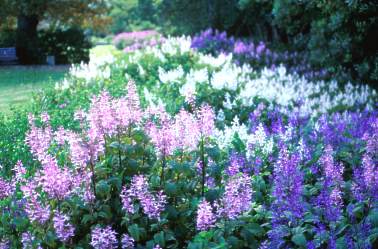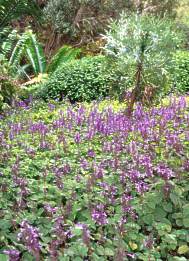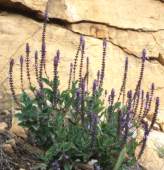Plectranthus
Plectranthus
Family: Lamiaceae
Common names:
Introduction
Plectranthus is the largest South African genus in the mint family (Lamiaceae), with 44 species natural to our region, most of which occur on the eastern side of the country.

Description
Description
Some species are narrowly endemic occurring only in a very limited area, while others are widespread and very variable and consequently difficult to distinguish.

Among the South African members of the genus we have some of the showiest garden plants providing a mass display of colour in late summer and autumn. Colour selections range between pink, purple and white and many shades in-between. Although there are two species which do have yellow flowers they are not good garden plants and their flowers are too small to be attractive.
Plectranthus are noted for their aromatic leaves when crushed or even brushed against, and the variety of aromas is as diverse as the genus itself.
Growing Plectranthus
Grow

Plectranthus are easily cultivated and require little extra attention or special treatment. They enjoy well-composted soils, and as rule thrive in semi shade or cool positions on south facing aspects. They are ideally suited to growth under the shade of trees. They are generally shallow rooted and enjoy adequate water but they do store water in their stems and are resistant to prolonged periods of drought. Plectranthus are often grown for their attractive foliage, flowers or both and vary in their growth forms from dense prostrate ground covers to sub-shrubs and large shrubs.
Although they are frost tender they are usually grown in shady protected places and as such are afforded some protection from frost. Due to the fact that they all flower at the end of the growing season frost does not affect flowering. If the plants are affected by frost they can be cut back at the end of winter and will grow out rapidly. Once the plants have been established for a year or more they become woodier at the base and are more resistant to frost damage.

Most of the shrubby species make better, more dense and attractive shrubs if they are pruned back to between 1/3 and 1/4 of their height, at the end of winter before the new growth begins for summer. After pruning is the ideal time to dress the soil with a thick layer of compost or organic mulch and an application of balanced fertilizer such as 2:3:2.Ground cover species rarely need to be pruned, other than occasional cleaning up of old growth and flower spikes.
The ground cover species often have very attractive foliage and form dense attractive carpets from 150mm to 450mm thick, which burst into flower in autumn. They root readily at the nodes wherever they touch the ground, and will form dense mats in a relatively short time.
Shrubby species vary in height from 0.5 - 2m and may be planted en-masse or as single individuals. Once again most species enjoy shade but there are a few which can endure full sun.
Plectranthus are exceptionally easy to propagate and can be produced very easily with little special treatment. Most propagation is done from cuttings during the early part of summer and spring. Although the cuttings will root at any time of the year, they have a long summer ahead to establish if they are propagated at this time. Cuttings may take the form of soft-wood, semi-hardwood, but tip cuttings are usually the best.
The cuttings should have at least two nodes and the leaves should be removed from the lower portion. Rooting hormone is usually not necessary and has been known to cause the cuttings to rot. The cuttings should be inserted one third of their length into clean double washed river sand and kept in a warm shady place and not be allowed to dry out.
Credits
Andrew Hankey
Witwatersrand National Botanical Garden
April 2001
Plant Attributes:
Plant Type: Ground Cover, Shrub
SA Distribution:
Soil type:
Flowering season:
PH:
Flower colour:
Aspect:
Gardening skill:
Special Features:
Horticultural zones






Rate this article
Article well written and informative
Rate this plant
Is this an interesting plant?
Login to add your Comment
Back to topNot registered yet? Click here to register.